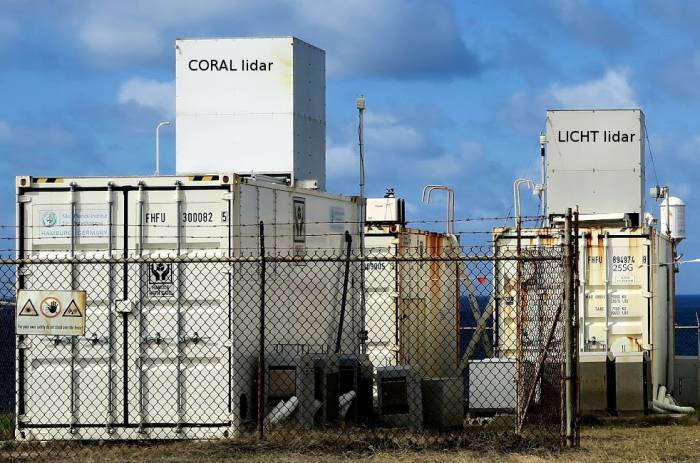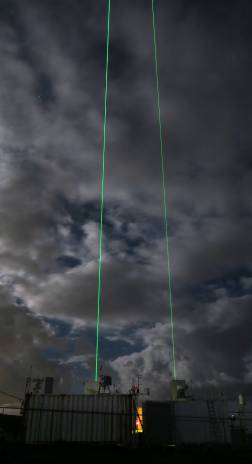Raman lidars at BCO
First MPI-M Raman lidar deployed at BCO in April 2010 was the EARLI system. Designed originally for EARLINET (European Aerosol Research LIdar NETwork, that is why the name EARLI) and for inland but not onshore operation, it was getting hard the impact of humid and salty ocean air. Slowly degrading in capabilities it nevertheless was up and running for the first six years of site operation staying only few meters off the ocean line. In 2016 EARLI lidar has been replaced at BCO with the next-generation system, LICHT (LIdar for Cloud, Humidity and Temperature profiling), which having similar measurement characteristics to EARLI was already designed for high isolation from outdoor environment. Third-generation MPI-M Raman lidar at BCO, the high power lidar component of CORAL system (Cloud Observation with Radar And Lidar), dedicated primarily for high resolution water vapor vertical profiling has been put in operation at BCO in May 2019.
Data handling concept
Lidar data collected at the BCO station are stored at the central storage maintained by CIS and could be accessed under:
/opt/pool/OBS/ACPC/RamanLidar-lidarName/ lidarName=EARLI|LICHT|CORAL
Each storage folder (lidarName being either EARLI, LICHT or CORAL) contains all the data measured with the particular lidar. There are four categories of data types common for all three lidars, these are raw, pre-processed, quicklooks and processed data.
Raw data represents the original output signals from data acquisition system being either the readings of analog to digital converter for signals digitized in analog mode or number of photons acquired in photon-counting mode. This data could be used to reproduce every other type of lidar data. Direct use of raw data for scientific purpose is not recommended as those data is not corrected for instrumental function. For instance, the impact of finite response time of data acquisition system is not eliminated, also the transmitter-receiver field-of-view overlap function is still present in the data. Raw data are sorted system-wise in monthly sorted structure under:
/opt/pool/OBS/ACPC/RamanLidar-lidarName/1_RawData/ lidarName=EARLI|LICHT|CORAL
Monthly folders with the template name “dataYYMM” contains data for the year 20YY and the month MM arranged as the daily tar volumes of data digitized either in analog or photon-counting mode (aYYMMDD.tar and rYYMMDD.tar, respectively). Each tar file for a given day combines a set of bzip2-compressed netcdf files with the raw data collected over one- or three-hour-long periods.
Pre-processed data is the first-step-processed signals used as an input for quicklook plotting and post-processing. Pre-processing algorithms include the following steps:
- correction for finite response time of photon-counting data acquisition system (dead-time correction)
- subtraction of solar light background (background correction)
- eliminating signal dependents on solid angle of receiving telescope aperture varying with range (range correction)
- averaging and rebinning signals in range and time (smoothing & rebinning)
- sorting data in daily containers with each container including photon-counted and analog signals for the particular day
Stored system-wise the pre-processed data are monthly-structured under:
/opt/pool/OBS/ACPC/RamanLidar-lidarName/2_PreProcessed/ lidarName=EARLI|LICHT|CORAL
Template name for monthly folders follows the pattern appYYMM assuming the year 20YY and the month number MM. Each monthly folder contains a set of bzipped netcdf files appYYMMDD.nc.bz2 with the day given by DD. Pre-processed data are considered to be partially suitable for scientific analysis but only in case if still missing correction for the transmitter-receiver field-of-view overlap function is not important for this study.
Quicklook data is the first produced instance of calibrated lidar products calculated in near real time in one hour after the measurements are done. The latest available set of system calibration constants is used for quicklook retrieval. Main target for the quicklook is, exactly as given with the name, to allow fast overview on the instrument performance, therefore the major component of the quicklook data are the timeseries plots stored in pdf format. Those plots could be accessed under:
/opt/pool/OBS/ACPC/RamanLidar-lidarName/3_QuickLook/pdf/ lidarName=EARLI|LICHT|CORAL
For historical reason the quicklook data for EARLI lidar are stored only as plots. For LICHT and CORAL beside the pdf plots we also keep quicklook data in netcdf format. Those files could be found under:
/opt/pool/OBS/ACPC/RamanLidar-lidarName/3_QuickLook/nc/ lidarName=LICHT|CORAL
Name assignment for quicklook netcdf files differs for different lidars and will be described for each instrument individually.
Processed data represents the finalized version of calibrated lidar data post-processed for recompiled set of system calibration constants, which are recalculated then for each measurement period. Compared to quicklooks the processed data also include a larger list of derived lidar products, specifically those that do require too much intensive computing (like particle extinction) or could not be automatically calibrated right after the measurements (like sometimes it is with air temperature).
/opt/pool/OBS/ACPC/RamanLidar-lidarName/4_Processed/ lidarName=EARLI|LICHT|CORAL
Presently the processed data are only produced for EARLI lidar while for LICHT and CORAL we consider the quicklook data to be the actual finalized version of calibrated lidar data. Name assignment for processed data files will be presented for each relevant system separately.

